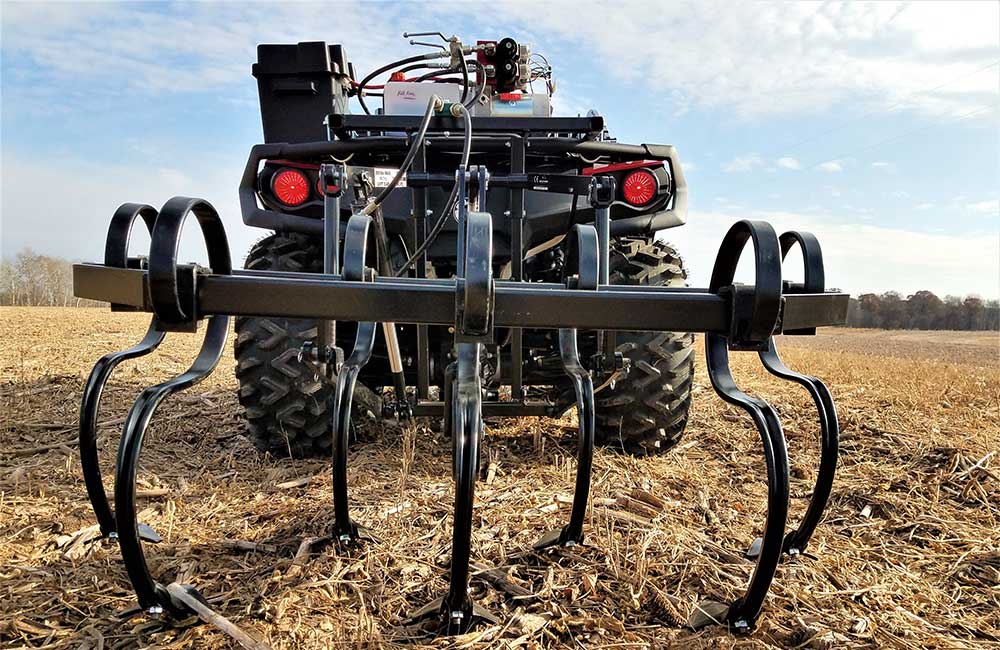Guide to 12-Volt Batteries: Everything You Need to Know
In this section, we will provide a course on the various types of 12-volt batteries. We will discuss cranking/starting vs. deep cycle batteries, the quality of batteries based on amp hours, their advantages and disadvantages, and groups (or sizes) so you can choose the best battery for your needs.

Cranking Batteries and Deep Cycle Batteries
Cranking/Starting Battery – The cranking or starting battery is used for quick and powerful bursts of energy to start an engine. The more inside lead plate surfaces the better for providing quick bursts of high energy. Many thin lead plates provide the necessary surface area. Pitting and warping, while appearing as a bulge in the lower portion of the battery, occur when cranking batteries are repeatedly discharged and recharged. Cranking batteries are available in flood lead-acid and absorbed glass mat (AGM).
Deep Cycle Batteries – The deep cycle battery is designed to operate over a long period of time with charging cycles done between the long discharge cycles. Deep cycle batteries have fewer, thicker lead plates that are much less likely to overheat during their long discharge cycles. Deep cycle batteries are designed to be discharged and recharged often. They are available in flood lead-acid, absorbed glass mat (AGM) and Lithium Iron Phosphate (LiFePO4).
Amp Hours – Each 12-volt battery has an amp hour rating or a cold cranking amp rating. The amp hour rating defines how many amps the battery can provide for what length of time. For instance, a 100 AH rated battery can provide energy to a 20 amp draw motor for 5 hours (100 / 20 = 5). Using a battery with a higher amp hour rating, you can operate that same 20 amp draw motor for longer. If you can’t find the amp hour rating on a battery, but you do know the Cold Cranking Amps (CCA), a general rule of thumb is to divide the CCA by 7.25 to determine the approximate amp hours of the battery. For example, if your battery is rated for 650 cold cranking amps, the approximate amp hours of the battery is 90 amps hours (650 / 7.25 = 90). The original amp hour rating on the battery will diminish with age.
Battery Types – Flood Lead-Acid, Absorbent Glass Mat (AGM) and Lithium Iron Phosphate (LiFePO4)
The job of a battery is to store and provide energy. The most commonly used types of 12-volt batteries are lead acid batteries, AGM (Absorbent Glass Mat) batteries, and lithium batteries. Most come in either a cranking (starting) or deep cycle design. Each type has its own unique characteristics and applications.
Flood lead-acid – Flood lead-acid batteries are the most common, readily available, and least expensive 12-volt battery available. They have been around for many years. Their voltage comes from a chemical reaction between the sulfuric acid and the lead plates within the battery.
Pros of a Flood Lead-Acid:
- The flood lead-acid battery is the least expensive 12-volt battery on the market. They start at approximately $100.
- In a cranking/starting configuration, flood lead-acid batteries are a great option for engines that require a quick burst of electricity to start. In a deep cycle configuration, they are effective at running equipment that draws less amperage for longer periods of time.
- It can be charged at a temperature below 32 degrees.
Cons of a Flood Lead-Acid:
- The life of a flood lead-acid battery is approximately 2 to 5 years.
- The lifespan can be affected by hot or cold temperatures, the draw down (discharge) rate, depth of discharge, and the charging process.
- They require the maintenance of keeping the liquid levels in the battery above the lead plates. Flood lead-acid batteries need to be used, stored, and charged in an area that is vented.
- As the battery is being used, the flood lead-acid battery’s voltage lowers gradually until there is not enough voltage to run your piece of equipment. It is recommended that only 30-50% of the available battery energy is discharged before recharging. Continual deep discharging of a lead-acid battery will result in premature failure.
- The lead plates are prone to sulfur buildup, which doesn’t allow the acid to contact the plates, reducing the effectiveness of the battery until it ultimately fails.
- They weigh 40 to 50 pounds.
Absorbent Glass Mat (AGM)
The AGM battery is a more advanced type of lead-acid battery, developed in the early ‘80s. There is a fiberglass mat between the positive and negative lead plates that “absorb” the sulfuric acid so it isn’t sloshing around in your battery case. The case is sealed.
Pros of an AGM:
- In a cranking/starting configuration, AGM batteries are a great option for engines which require a quick burst of electricity to start. In a deep cycle configuration, they are effective at running equipment that draws less amperage for longer periods of time .
- They offer up to an 80% depth of discharge rate.
- They will reach full charge up to 5 times faster than a flood lead-acid battery.
- It can be charged at a temperature below 32 degrees. Their lifespan and effectiveness are not affected nearly as much by hot and cold temperatures, compared to flood lead-acid batteries.
- Since AGM batteries are sealed, they generally do not require the maintenance that flood lead-acid batteries require.
- They can be placed on their sides and can be mounted in areas that are not vented, providing flexibility in mounting locations.
- They provide good shock and vibration resistance.
Cons of an AGM:
- The life of an AGM battery is 3 to 6 years.
- They are roughly twice the price ($200-$300) of a flood lead-acid battery.
- The discharge rate of the electricity in the battery is very similar to flood lead-acid batteries, although they do offer a greater depth of discharge. As the battery is being used, the AGM battery’s voltage lowers gradually until there is not enough voltage to run your piece of equipment.
- Continual deep discharging (beyond 80%) will result in premature failure.
- They require a special battery charger.
- They are more sensitive to overcharging and high voltages than flood lead-acid batteries.
- The lead plates are less prone to sulfur buildup (but still a concern), which doesn’t allow the acid to contact the plates, which doesn’t allow the acid to contact the plates, so it reduces the effectiveness of the battery until it ultimately fails.
- They are similar in weight to a flood lead-acid battery.
Lithium Iron Phosphate (LiFePO4)
LiFePO4 is a sub-type of lithium-ion batteries that are safer, have a wider use temperature range, and allow for many more charging cycles. Lithium-ion batteries were invented in the early 1900s, and the first commercialized battery was sold in 1991. In the past 10 years, the popularity of lithium-ion batteries has grown and their price has dropped. The battery is made of an anode, cathode, separator, electrolyte, two current collectors and a BMS (battery management system).
Pros of a LiFePO4:
- LiFePO4 batteries provide high energy and a long lifespan (approximately 10 times the number of charging cycles of a lead battery—3000 to 10,000 cycles). They generally last 6 to 10 years or more.
- They can be charged with a higher amperage battery charger (approximately 50 amps), so they are capable of charging at a much faster rate than other batteries.
- Unlike lead-acid batteries, LiFePO4 batteries do not gradually lose voltage during discharge, but rather maintain their voltage though their discharge cycle and then abruptly stop. The maximum discharge depth is generally 98 to 100%.
- They contain a battery management system (BMS) that protects them and monitors the battery’s voltage, charging parameters, temperature, etc. A good BMS provides temperature protection, smart cell balancing, a communication module, a Bluetooth module, electronic switch, a self-heating module, battery parameter monitoring, battery discharge management, and more.
- They may be cheaper in price in the long run when considering the long life of the battery.
- LiFePO4 batteries have a high energy to weight ratio. A 12-volt LiFePO4 battery (100 AH) typically only weighs 20 to 30 pounds.
- They are considered environmentally friendly.
Cons of a LiFePO4:
- LiFePO4 batteries are more expensive ($200 to $1200) upfront and more complex than other types of batteries.
- LifePO4 batteries are not recommended for cranking/starting applications.
- Some BMSs do not include all the available protection and monitors. LiFePO4 batteries can require extensive research in order to get the right battery for your needs.
- Most LiFePO4 manufacturers recommend an operating temperature range of -4 °F to 140 °F, and a charging range of 32 °F to 131 °F. If you charge outside of the manufacturer’s recommended range, you are likely to damage the battery severely and permanently.
- LiFePO4 batteries require a special battery charger.
- LiFePO4 is not considered a fully mature technology.
Group Sizes of 12-Volt Batteries
Group sizes and categories are used to classify 12-volt batteries based on their physical dimensions and terminal placement. These group sizes ensure compatibility with specific vehicles or equipment. Here is a list of a few of the common groups and sizes:
Group 24 10.25” x 6.8125” x 8.875” Available in 70 to 85 Amp Hours
Group 27 12.0625” x 6.8125” x 8.875” Available in 85 to 110 Amp Hours
Group 31 13” x 6.8125” x 9.4375” Available in 95 to 125 Amp Hours
(Batteries are also available in group 34, 35, 51, 65, 78, 8D, etc.)

 100% Designed & Manufactured in the USA, with some foreign parts.
100% Designed & Manufactured in the USA, with some foreign parts.














